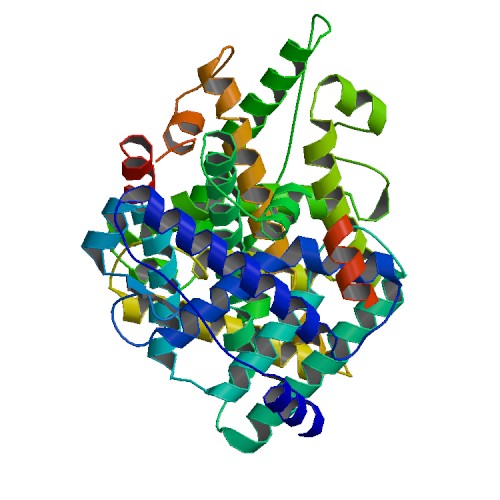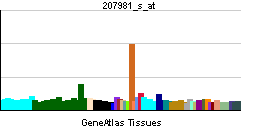Estrogen-related receptor gamma
| Estrogen-related receptor gamma | |||||||||||||
|---|---|---|---|---|---|---|---|---|---|---|---|---|---|
 PDB rendering based on 1kv6. | |||||||||||||
| |||||||||||||
| Identifiers | |||||||||||||
| Symbols | ESRRG ; DKFZp781L1617; ERR3; FLJ16023; KIAA0832; NR3B3 | ||||||||||||
| External IDs | Template:OMIM5 Template:MGI HomoloGene: 55581 | ||||||||||||
| |||||||||||||
| RNA expression pattern | |||||||||||||
 | |||||||||||||
 | |||||||||||||
| More reference expression data | |||||||||||||
| Orthologs | |||||||||||||
| Template:GNF Ortholog box | |||||||||||||
| Species | Human | Mouse | |||||||||||
| Entrez | n/a | n/a | |||||||||||
| Ensembl | n/a | n/a | |||||||||||
| UniProt | n/a | n/a | |||||||||||
| RefSeq (mRNA) | n/a | n/a | |||||||||||
| RefSeq (protein) | n/a | n/a | |||||||||||
| Location (UCSC) | n/a | n/a | |||||||||||
| PubMed search | n/a | n/a | |||||||||||
Estrogen-related receptor gamma (ERR-gamma), also known as NR3B3 (nuclear receptor subfamily 3, group B, member 3), is a nuclear receptor which is encoded by the gene ESRRG (EStrogen Related Receptor Gamma).[1]
This protein is a member of nuclear hormone receptor family of steroid hormone receptors. No physiological activating ligand is known for this orphan receptor, but 4-hydroxytamoxifen and diethylstilbestrol act as inverse agonists and deactivate ESRRG.
References
Further reading
- Bonaldo MF, Lennon G, Soares MB (1997). "Normalization and subtraction: two approaches to facilitate gene discovery". Genome Res. 6 (9): 791–806. PMID 8889548.
- Eudy JD, Yao S, Weston MD; et al. (1998). "Isolation of a gene encoding a novel member of the nuclear receptor superfamily from the critical region of Usher syndrome type IIa at 1q41". Genomics. 50 (3): 382–4. doi:10.1006/geno.1998.5345. PMID 9676434.
- Nagase T, Ishikawa K, Suyama M; et al. (1999). "Prediction of the coding sequences of unidentified human genes. XII. The complete sequences of 100 new cDNA clones from brain which code for large proteins in vitro". DNA Res. 5 (6): 355–64. PMID 10048485.
- Chen F, Zhang Q, McDonald T; et al. (1999). "Identification of two hERR2-related novel nuclear receptors utilizing bioinformatics and inverse PCR". Gene. 228 (1–2): 101–9. PMID 10072763.
- Hong H, Yang L, Stallcup MR (1999). "Hormone-independent transcriptional activation and coactivator binding by novel orphan nuclear receptor ERR3". J. Biol. Chem. 274 (32): 22618–26. PMID 10428842.
- Heard DJ, Norby PL, Holloway J, Vissing H (2000). "Human ERRgamma, a third member of the estrogen receptor-related receptor (ERR) subfamily of orphan nuclear receptors: tissue-specific isoforms are expressed during development and in the adult". Mol. Endocrinol. 14 (3): 382–92. PMID 10707956.
- Greschik H, Wurtz JM, Sanglier S; et al. (2002). "Structural and functional evidence for ligand-independent transcriptional activation by the estrogen-related receptor 3". Mol. Cell. 9 (2): 303–13. PMID 11864604.
- Wistow G, Bernstein SL, Wyatt MK; et al. (2002). "Expressed sequence tag analysis of human RPE/choroid for the NEIBank Project: over 6000 non-redundant transcripts, novel genes and splice variants". Mol. Vis. 8: 205–20. PMID 12107410.
- Hentschke M, Süsens U, Borgmeyer U (2002). "Domains of ERRgamma that mediate homodimerization and interaction with factors stimulating DNA binding". Eur. J. Biochem. 269 (16): 4086–97. PMID 12180985.
- Hentschke M, Süsens U, Borgmeyer U (2003). "PGC-1 and PERC, coactivators of the estrogen receptor-related receptor gamma". Biochem. Biophys. Res. Commun. 299 (5): 872–9. PMID 12470660.
- Strausberg RL, Feingold EA, Grouse LH; et al. (2003). "Generation and initial analysis of more than 15,000 full-length human and mouse cDNA sequences". Proc. Natl. Acad. Sci. U.S.A. 99 (26): 16899–903. doi:10.1073/pnas.242603899. PMID 12477932.
- Hentschke M, Schulze C, Süsens U, Borgmeyer U (2003). "Characterization of calmodulin binding to the orphan nuclear receptor Errgamma". Biol. Chem. 384 (3): 473–82. PMID 12715898.
- Hentschke M, Borgmeyer U (2004). "Identification of PNRC2 and TLE1 as activation function-1 cofactors of the orphan nuclear receptor ERRgamma". Biochem. Biophys. Res. Commun. 312 (4): 975–82. PMID 14651967.
- Ota T, Suzuki Y, Nishikawa T; et al. (2004). "Complete sequencing and characterization of 21,243 full-length human cDNAs". Nat. Genet. 36 (1): 40–5. doi:10.1038/ng1285. PMID 14702039.
- Gerhard DS, Wagner L, Feingold EA; et al. (2004). "The status, quality, and expansion of the NIH full-length cDNA project: the Mammalian Gene Collection (MGC)". Genome Res. 14 (10B): 2121–7. doi:10.1101/gr.2596504. PMID 15489334.
- Cheung CP, Yu S, Wong KB; et al. (2005). "Expression and functional study of estrogen receptor-related receptors in human prostatic cells and tissues". J. Clin. Endocrinol. Metab. 90 (3): 1830–44. doi:10.1210/jc.2004-1421. PMID 15598686.
- Liu D, Zhang Z, Teng CT (2005). "Estrogen-related receptor-gamma and peroxisome proliferator-activated receptor-gamma coactivator-1alpha regulate estrogen-related receptor-alpha gene expression via a conserved multi-hormone response element". J. Mol. Endocrinol. 34 (2): 473–87. doi:10.1677/jme.1.01586. PMID 15821111.
- Gao M, Sun P, Wang J; et al. (2006). "Expression of estrogen receptor-related receptor isoforms and clinical significance in endometrial adenocarcinoma". Int. J. Gynecol. Cancer. 16 (2): 827–33. doi:10.1111/j.1525-1438.2006.00527.x. PMID 16681769.
- Gregory SG, Barlow KF, McLay KE; et al. (2006). "The DNA sequence and biological annotation of human chromosome 1". Nature. 441 (7091): 315–21. doi:10.1038/nature04727. PMID 16710414.
- Wang L, Zuercher WJ, Consler TG; et al. (2007). "X-ray crystal structures of the estrogen-related receptor-gamma ligand binding domain in three functional states reveal the molecular basis of small molecule regulation". J. Biol. Chem. 281 (49): 37773–81. doi:10.1074/jbc.M608410200. PMID 16990259.
| This protein-related article is a stub. You can help Wikipedia by expanding it. |